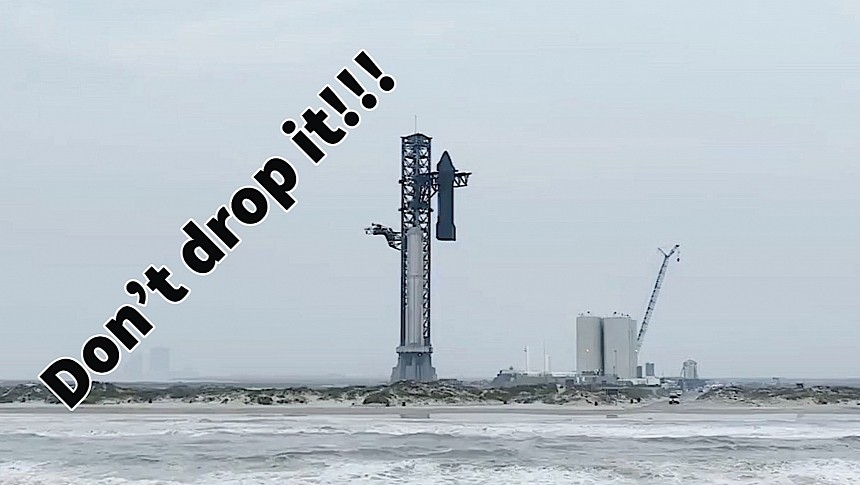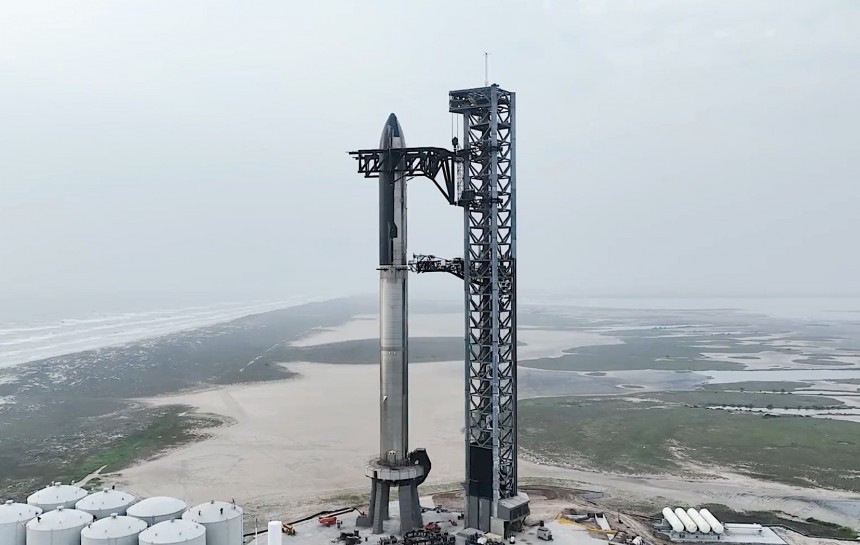Assembling a rocket-spacecraft combo for launch is a complicated and exciting business. It’s the process through which a spaceship is connected to its booster(s) and other required equipment it needs, and it most often than not, as least when it comes to NASA, takes place behind closed doors, inside specially equipped buildings. But that’s not how SpaceX is doing things.
Elon Musk’s space company is getting ready for the first orbital flight of the Starship. As per the man himself, the moment we’ve all been waiting for should be upon us as soon as next week, “pending regulatory approval.”
At the time you’re reading this, the Starship is fully stacked at the company’s location in Boca Chica, Texas. That means the Ship 24 spaceship is now connected to the Booster 7 Super Heavy first-stage rocket, and the combo tied to the launch tower that will help it get on its way.
A few hours ago, however, things were just coming together. You can see how that unfolded in the video attached below, but be warned, there are images in there that are both distressing and comforting at the same time.
The video starts with the Starship caught in the claws of its support equipment, dangling many feet above the ground below. At this point, the ship has no direct connection to the ground per se, looking like a precariously balanced half-rocket about to be dropped to the ground.
But then the reality of the images hits you. Starship is dangling above the ground because it awaits its booster, the one that will finally send it into orbit and prove that yet another crew-capable space machine has arrived. One that should, years from now, really open up the Moon and Mars for us.
Although simple in design, the first Starship orbital flight is crucial for the development of future versions of it. When it departs (we hope to learn the exact launch time soon), the booster will push Starship into orbit, then come down to land on its designated pad.
After separation, the Starship will move higher up and enter an orbit that will take it one time around our planet. After it completes the mission, it will come back down to Earth, to splash down off the coast of Hawaii. The entire flight is not expected to last more than 90 minutes, but they’ll likely be the minutes that either make or break the design.
If all goes according to plan, the ignition of the booster’s 33 Raptor engines, each developing 510,000 lbf of thrust, could make the Starship the most powerful rocket ever flown.
Before launching Starship, SpaceX plans to conduct a launch rehearsal, so we’ll also keep an eye out for that.
At the time you’re reading this, the Starship is fully stacked at the company’s location in Boca Chica, Texas. That means the Ship 24 spaceship is now connected to the Booster 7 Super Heavy first-stage rocket, and the combo tied to the launch tower that will help it get on its way.
A few hours ago, however, things were just coming together. You can see how that unfolded in the video attached below, but be warned, there are images in there that are both distressing and comforting at the same time.
The video starts with the Starship caught in the claws of its support equipment, dangling many feet above the ground below. At this point, the ship has no direct connection to the ground per se, looking like a precariously balanced half-rocket about to be dropped to the ground.
Although simple in design, the first Starship orbital flight is crucial for the development of future versions of it. When it departs (we hope to learn the exact launch time soon), the booster will push Starship into orbit, then come down to land on its designated pad.
After separation, the Starship will move higher up and enter an orbit that will take it one time around our planet. After it completes the mission, it will come back down to Earth, to splash down off the coast of Hawaii. The entire flight is not expected to last more than 90 minutes, but they’ll likely be the minutes that either make or break the design.
If all goes according to plan, the ignition of the booster’s 33 Raptor engines, each developing 510,000 lbf of thrust, could make the Starship the most powerful rocket ever flown.
Before launching Starship, SpaceX plans to conduct a launch rehearsal, so we’ll also keep an eye out for that.
Starship preparing for launch ???? pic.twitter.com/M1pR8rsmYt
— Elon Musk (@elonmusk) April 6, 2023











